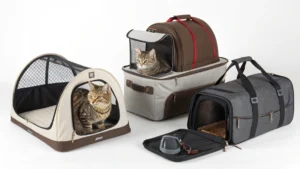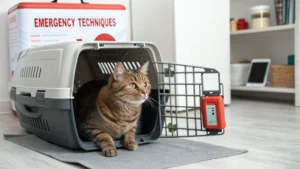Every cat owner knows the heart-racing moment when it’s time to transport your feline friend. The mere sight of a carrier can turn your usually calm kitty into a bundle of resistance. Learning how to get my cat in her carrier doesn’t have to be a battle of wills—it can be a calm, stress-free experience with the right approach.
Cats are intuitive creatures who sense our emotions instantly. Your anxiety about putting them in a carrier can trigger their own stress response. Understanding how to put a cat in a carrier easily requires patience, strategy, and a deep connection with your furry companion.
Transportation doesn’t have to be traumatic. With the right techniques, you can transform the carrier from a source of fear to a safe space your cat might even welcome. This guide will walk you through practical, compassionate methods to make carrier time a positive experience.
Understanding Why Cats Resist Carriers and Travel
Many cat owners wonder why their pets hate carriers. It’s a common problem. Cats have instincts that make traveling hard for them.
Natural Territorial Behavior and Stress Triggers
Cats feel safe in their own space. Carriers are new and scary to them. Knowing this helps us find ways to make travel less stressful.
- Confined spaces feel threatening to cats
- Strange smells increase anxiety
- Lack of control triggers defensive responses
Common Misconceptions About Cat Carriers
Some think cats will easily get used to carriers. But, every cat is different and reacts in their own way.
The Impact of Past Negative Experiences
Bad travel experiences can really scare cats. One bad trip can make them always fear carriers.
Understanding your cat’s perspective is key to reducing travel-related stress.
How To Get My Cat In Her Carrier: Essential Preparation Steps
Getting a stubborn cat into a carrier needs patience and planning. The right preparation can turn a stressful moment into a smooth one for both you and your cat.
Begin by picking a quiet spot for the carrier introduction. Choose a room where your cat feels safe and calm. Place the carrier in a spot where your cat can easily access it, with the door open.
- Create positive associations with the carrier through treats and favorite toys
- Leave the carrier out permanently so it becomes a familiar object
- Use soft blankets or your cat’s preferred bedding inside the carrier
Make the carrier a safe space for your cat. Add catnip or treats to encourage curiosity. Some cats also benefit from pheromone sprays to reduce stress.
Patience is key when getting a stubborn cat into a carrier. Never force your cat, as this can create lasting negative associations.
Practice short carrier sessions without traveling. Let your cat get used to the carrier on their own terms. Reward calm behavior with treats and praise to build a positive bond.
Remember, every cat is different. What works for one might not work for another. Be ready to try different methods to find what works best for your cat.
Choosing the Right Carrier for Your Feline Friend
Finding the best cat carrier for anxious cats can greatly improve their travel experience. Not all carriers are the same. You need to pick one that meets your cat’s specific needs.
When looking for the perfect carrier, several important factors come into play. Your aim is to create a safe, comfy space for your cat. This space should help your cat feel secure while traveling.
Top Features to Look For
- Multiple entry points for easy access
- Secure and reliable closures
- Ventilation windows
- Soft, padded interior
- Lightweight and durable material
Size and Material Matters
The right size is key when teaching your cat to like a carrier. Pick a carrier where your cat can stand, turn, and lie down easily. Soft-sided carriers are great for anxious cats. They offer a flexible, less scary environment.
Making the Carrier Inviting
Turn the carrier into a cozy retreat. Add a familiar blanket, some catnip, or your cat’s favorite treats. The goal is to make the carrier a safe, welcoming space.
Remember, patience and consistency are your best tools in helping your cat feel comfortable with their carrier.
Training Your Cat to Love Their Carrier
Changing your cat’s view of a carrier from scary to cozy takes time and smart training. Begin by making the carrier a safe and welcoming place. This is the first step in getting your cat to see the carrier as a good thing.
Put the carrier in a spot your cat likes in your home. Make the carrier a place your cat wants to be:
- Sprinkle favorite treats inside the carrier
- Add soft blankets with your cat’s scent
- Place interactive toys near or inside the carrier
- Use calming pheromone sprays to reduce anxiety
Consistency is key when training your cat to love their carrier. Let your cat explore the carrier on their own terms. Keep the door open and make it a place of curiosity.
“Patience transforms carrier training from a stressful experience to a bonding opportunity” – Veterinary Behavioral Experts
Give your cat treats and praise when they go near or into the carrier. Use short, fun training sessions. Slowly increase the time they spend inside, keeping it a positive experience.
Every cat is different. Some may take longer to get used to the carrier. Be patient and keep the training fun and easy.
Quick and Effective Techniques for Emergency Situations
When you need to get your cat into a carrier fast, staying calm is key. Unexpected vet visits or travel emergencies can make your cat very anxious. It’s important to know how to get a scared cat into a carrier with patience and a smart plan.
But efore you even think about the carrier, make sure you’ve covered the basics in this guide on what to do before getting a new cat at home .
Cats can pick up on your emotions, so it’s vital to stay calm. Quick or forceful actions will only make them more scared and resistant.
Safe Handling Methods
Proper handling is crucial when dealing with an aggressive cat. Here are some important techniques:
- Wrap your cat in a thick towel to prevent scratching
- Support their body weight completely
- Keep movements slow and predictable
- Approach from the side, not directly head-on
Using Treats and Positive Reinforcement
Treats can be a great tool to make carrier entry less stressful. Soft, smelly treats are the best to distract and attract your cat.
- Place favorite treats near and inside the carrier
- Use calming pheromone sprays
- Reward your cat immediately after successful carrier entry
Dealing with Aggressive or Frightened Cats
“Patience transforms fear into trust” – Veterinary Behaviorist
When your cat gets defensive, don’t confront them directly. Create a calm space, speak softly, and never punish them for being scared. If your cat is persistently aggressive, you might need professional help.
Conclusion
Getting your cat into a carrier doesn’t have to be stressful. By using the strategies we’ve talked about, you can make travel easier for both you and your cat. Remember, patience and practice are crucial to making carrier time calm and comfortable.
Understanding your cat’s needs and fears is the first step to a stress-free vet visit. The methods we’ve discussed, like creating a positive carrier environment, can help your cat feel more at ease. Every success you have helps build your cat’s confidence for future trips.
By being gentle and using positive reinforcement, you can make your cat see the carrier as a safe place. Every cat is unique, so be ready to adjust these strategies to fit your cat’s personality and comfort level.
Carrier training is an ongoing journey. Keep practicing, use lots of treats, and stay calm. Your patience and understanding can turn a tough situation into a smooth, stress-free experience for both of you.
FAQ
Why do cats hate carriers so much?
Cats are territorial and feel scared when confined. Carriers seem scary and disrupt their sense of safety. Bad experiences, like stressful vet visits, make them fear carriers.
How can I help my cat feel more comfortable in a carrier?
Make the carrier a cozy space. Add soft blankets and treats. Let your cat explore it on their own terms.
Never force them inside. Feed meals near or inside the carrier to build positive associations.
What type of carrier is best for a nervous cat?
Choose carriers with easy entry points and soft sides. Top-loading carriers are less stressful. They let you gently place your cat inside.
Hard-sided carriers with removable tops also offer security and easy access.
How can I quickly get my cat into a carrier for an emergency?
Use treats or a favorite toy to lure them. Move calmly and avoid sudden actions. Wrap them in a familiar blanket to reduce stress.
If needed, use a towel to gently guide them into the carrier.
How far in advance should I start carrier training?
Start training early, ideally when your cat is a kitten. But it’s never too late. Consistent training over weeks can help.
Practice short, positive sessions several times a week.
Can I use sedatives to help my cat into a carrier?
Only use sedatives if your vet prescribes them. Sedation should be a last resort. Most cats do better with positive reinforcement and gradual training.
How do I prevent my cat from becoming stressed during travel?
Use a light blanket to cover the carrier. Play calming music and use pheromone sprays. Keep the carrier stable and avoid sudden movements.
Choose a carrier that feels secure but has good ventilation. Practice short trips to build confidence.
What if my cat becomes aggressive when I try to put them in a carrier?
Stay calm and avoid punishment. Use gloves if needed, and gently wrap your cat in a towel. Try different approaches like using treats or playing before transport.
If aggression persists, seek help from a vet or animal behaviorist for personalized strategies.



